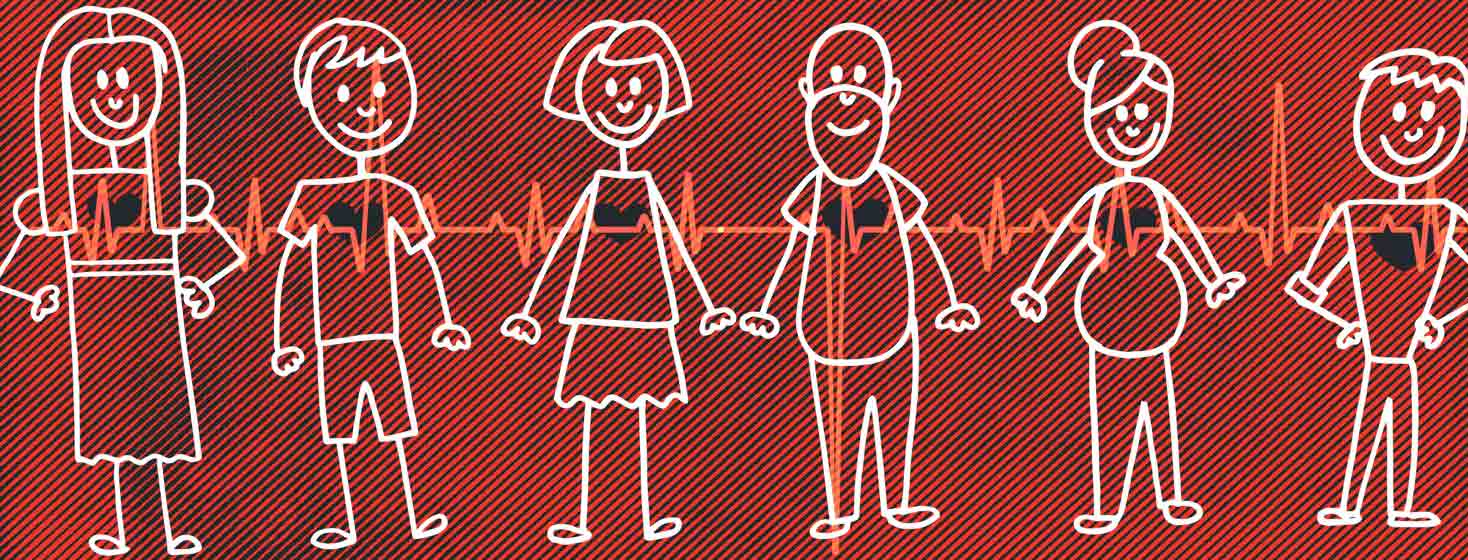Types of Arrhythmias
An arrhythmia is an abnormal heartbeat. This includes heartbeats that are too slow, too fast, or irregular. Arrhythmias happen when electrical signals in the heart do not work properly.1-3
A regular heart rate is important to pump enough blood to the rest of the body. Some types of arrhythmias are harmless. Others are serious and can lead to your heart stopping (cardiac arrest). Talk to your doctor about your symptoms. They can perform tests to identify the type of arrhythmia and suggest treatments.1,2
What are tachycardia and bradycardia?
A normal resting heart rate is between 60 and 100 beats per minute. Arrhythmias often lead to a fast or slow heart rate. These are called:2-4
- Tachycardia – a fast heartbeat (over 100 beats per minute)
- Bradycardia – a slow heartbeat (less than 60 beats per minute)
A faster or slower heartbeat may be healthy and normal. For example, your heart rate may increase during exercise and decrease while you sleep. But long-term tachycardia or bradycardia may be a sign of an arrhythmia.2
What are the main types of arrhythmias?
Doctors describe arrhythmias by where in the heart they start. The main types of arrhythmias include:
Supraventricular tachycardia (SVT)
In SVT, a fast heart rate starts in the upper chambers of the heart (the atria). There are several types of SVT, including:1,2,5,6
- Atrial fibrillation (A-fib) – chaotic heart signaling with a rapid heartbeat
- Atrial flutter – similar to A-fib, but with more organized heartbeats
- Atrial tachycardia – when upper chambers beat faster than lower chambers
- Premature atrial contractions – usually harmless condition that feels like extra heartbeats
- Paroxysmal SVT – short-circuit rhythm develops in the upper chamber
- Wolff-Parkinson-White syndrome – when an abnormal pathway conducts electrical current through the heart
A-fib is the most common type of arrhythmia. More than 2.5 million people in the United States have A-fib. It can lead to a stroke and other serious health conditions. People with lung and heart disease have a higher risk of A-fib. Other types of SVT are more common for people with certain risk factors.1,2,5,7
A-fib and atrial flutter are often separated into their own category. This is because they have different risks than other types of SVT. They may also involve different heart process problems.4,5,7,8
Ventricular arrhythmia
In ventricular arrhythmia, a fast heart rate starts in the lower heart chambers (the ventricles). The ventricles pump blood out of the heart. Disruption to their normal rhythm can cause serious problems.1,2,9
The main types of ventricular arrhythmia are:9
- Preventricular contractions – usually harmless condition that feels like extra heartbeats
- Ventricular tachycardia – when the ventricles beat too fast
- Ventricular fibrillation (V-fib) – when the ventricles twitch instead of expanding and contracting
V-fib is the most serious type of ventricular arrhythmia. Blood cannot pump through the ventricles. This can cause cardiac arrest.9
Bradyarrhythmia
Bradyarrhythmia refers to a slow heart rate caused by an arrhythmia. This is different from a slow heart rate caused by sleep or good fitness. Bradyarrhythmia can lead to serious health problems.1,10
The main types of bradyarrhythmia include:10
- Sinus node dysfunction – problems with the heart’s natural pacemaker
- Heart block – when something gets in the way of the heart’s electrical signals
- Bradycardia/tachycardia syndrome – alternating periods of slow and fast heart rates
What are symptoms of an abnormal heart rhythm?
Specific symptoms depend on the type of arrhythmia. Some people do not show any symptoms. When symptoms appear, they can include:1,4,5,9,10
- Chest pain (angina)
- Fast heartbeat
- Lightheadedness, dizziness, or fainting
- Sweating
- Fatigue
- Fluttering in the chest (heart palpitations)
- Shortness of breath
Serious arrhythmias can lead to unconsciousness or cardiac arrest. There is often no warning sign before this happens. Sometimes, symptoms appear a few minutes before the person passes out.1,7
What causes abnormal heart rhythms?
Arrhythmias are caused by problems with electrical signals in the heart. Certain triggers often cause symptoms for people with SVT. Some people are not aware of their trigger. Common triggers and risk factors include:1,5
- Stress
- Caffeine
- Alcohol
- Cigarette smoke
A-fib, ventricular arrhythmia, and bradyarrhythmia are often caused by heart conditions or damage to the heart. These include:1,4,7,9,10
- Diseases of the heart muscle or valves
- Heart attack or failure
- Heart inflammation
- Heart surgery
- Blunt impacts to the chest
- Certain medicines
- Thyroid or lung conditions
How are irregular heartbeats treated?
Some people do not need treatment for an arrhythmia. It may be enough to avoid triggers that cause symptoms. This includes lifestyle changes, such as:1,5
- Resting more
- Drinking less coffee
- Drinking less alcohol
- Quitting smoking
More serious or long-term arrhythmias may require treatment. Talk to your doctor about the risks and benefits of different treatments. Your doctor may suggest:1,9,10
- Treating underlying conditions (such as thyroid conditions)
- Antiarrhythmic drugs
- Medicines to slow down the heart
- Drugs that reduce the risk of blood clots
- Inserting devices, such as a pacemaker
- Procedure, such as catheter ablation
- Surgery

Join the conversation